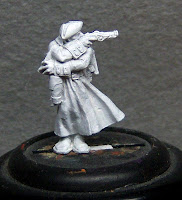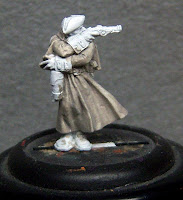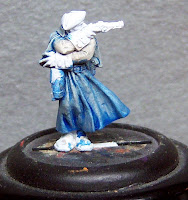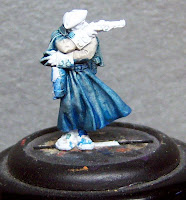Goal #3 for 2011: Do a series of posts on "speed painting".
It's high time I got started on this goal! This is the kick-off post for the SPQR series I'll be doing on an ongoing basis to tackle the large topic of speed painting. My goal is to give a balance between the "philosophy" of speed painting, and concrete examples of speed painting in practice.
Philosophy
The term "speed painting" has a pretty wide spectrum of definition for time, technique and quality. Those definitions vary primarily due to different goals, which each painter needs to define for themselves. Are you looking to get a painted army on the table? Are you looking to improve your brush handling techniques? Is your available painting time limited and you're looking to balance quality and completion? The goal is what will drive what type speed painting you undertake.
In my case, I have 2 goals. The secondary goal is to get stuff painted for playing with. But my primary goal is really to improve my skills. My underlying theory is that I can always buy another copy of a model rather than strip and start over if it isn't perfect. I've been doing this sort of balance between speed and quality for the last couple years and I've seen a noticeable improvement in both brush accuracy and blending quality. One key factor to this improvement is that I always take time after I seal a model to review what I liked and what I didn't like, even if I don't blog about it. Occasionally I will set aside the speed painting mentality and go all-out on a model just to test where my upper limit is, but I can honestly say that taking this specific speed painting philosophy has indeed improved my skills.
Ok, enough of the philosophy, let's start a real example...
Practice
For the practice portion of these posts, I'm going to start with this unit of Gun Mages. They've been sitting in my paint queue for quite a while now, and although I don't expect to be playing them in the very near future I do want to get them painted. I should note that this is my second unit of Gun Mages to have painted (the first unit being
here), so I've got the upper hand on these so to speak.
 | Here's my starting point... a white primed model. I'm actually painting the whole unit at once, but I'm only going to show one model for the purposes of demonstrating the progress.
I'm using a "wash over white" technique to help speed up the process of the major areas. The idea is that the washes over white do a lot of the hard work in terms of highlighting and shading. It's certainly not competition quality, but for tabletop standards it gets good results. Note that I'm not going to discuss other primer color options here. This technique is specifically for white primer. |
 | First painting step, base wash with Trollblood Highlight 1:1 (paint:water ratio). You'll notice that the coverage here is pretty good. Some white shows through, but not a whole lot. I'm starting with a more gray base before going to blues just to give it a more military feel. |
 | Step 2, wash with Cygnar Blue Base 1:2:1 (paint:water:matte medium). The coverage here is significantly less, but it does create a translucent glaze over the entire thing.
The reason reason I include matte medium rather than glaze medium is that it 1) helps glaze even the top surfaces, and 2) helps reduce reflectivity in the recesses. |
 | Step 3, wash with VMC Dark Sea Blue 1:3:1 (paint:water:matte medium). Similar goal as the previous step, just darkening things.
Now normally there's a lot of advice about painting the recessed areas first, and moving to the higher areas to avoid making mistakes on completed areas. The reason I'm doing the washes first is simply that washes tend to be messy, especially when working fast. Doing the washes first means I won't slop on other areas later and cause more damage. |
And there you go, about 1/3 of the model's entire surface has already been covered using this technique. It's not outstanding, but it gets the job done.
Total painting time: 30 minutes. Ok, let me add a caveat there. I did paint 7 of these guys at the same time ("assembly line" style), but it was about 30 minutes of actual time spent mixing paint and applying it. There was drying time in between, but I'm not going to count that. The reason being that I spent drying time working on other projects at the same time.
Feedback!
If you've made it this far, thanks! I'm planning to keep these relatively short and work my way through my backlog of unpainted models, so expect more in the near future. This being the first post in what I hope will be a continuing series, I'd love to get feedback on what would be useful in future posts.